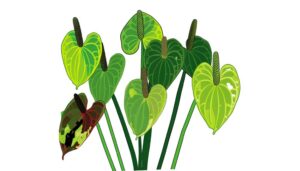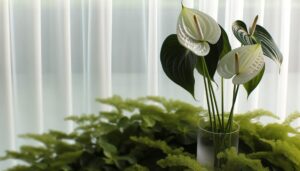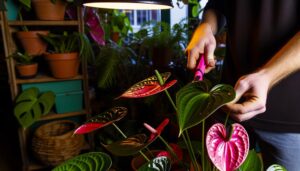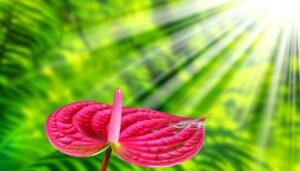How to Care for a Pink Bird Anthurium
To care for your Pink Bird Anthurium, place it in bright, indirect light and rotate periodically. Maintain temperatures between 65°F and 80°F, avoiding drafts.
Water weekly when the top inch of soil feels dry, using distilled or rainwater. Use a well-draining, airy soil mix with components like orchid bark, perlite, and peat moss.
Keep humidity between 60% and 80%, using a humidifier if needed. Prune dead or yellow leaves with sterilized shears and clean the foliage regularly.
Watch for common pests like spider mites and aphids. Follow these steps to ensure your Anthurium thrives and looks its best.
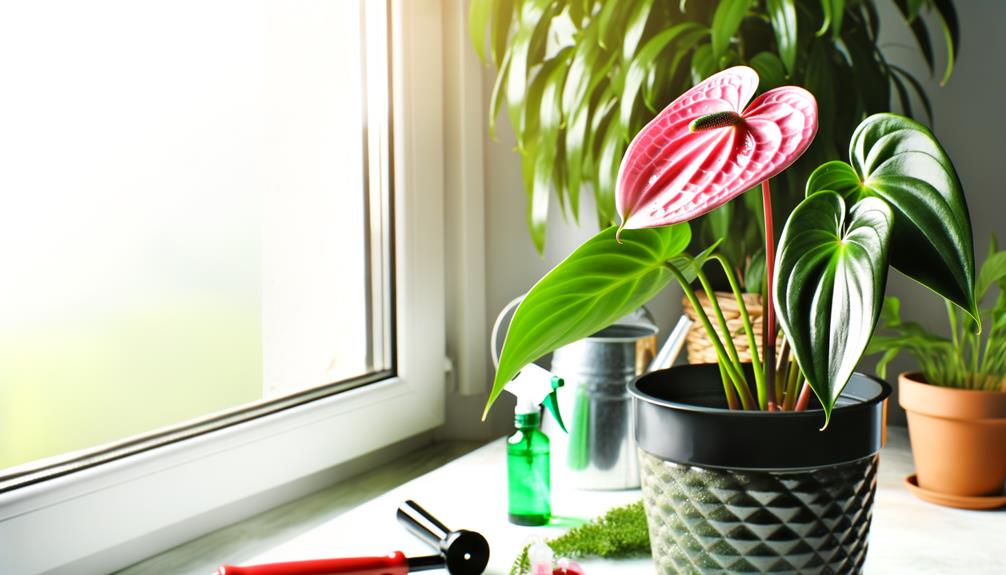
Key Takeaways
- Provide bright, indirect light and rotate periodically to ensure even light distribution.
- Maintain a consistent watering schedule, watering when the top inch of soil is dry.
- Ensure humidity levels between 60% and 80% using a humidifier or by misting leaves.
- Use well-draining soil with components like orchid bark, perlite, and peat moss.
- Regularly inspect for pests like spider mites, aphids, and mealybugs, treating with appropriate methods.
Light Requirements
Although the Pink Bird Anthurium thrives in bright, indirect light, it can't tolerate direct sunlight as it may scorch its delicate leaves. Position it near an east or north-facing window where it can receive diffused light.
If natural light is insufficient, consider using a grow light with a spectrum of 400 to 700 nanometers, replicating the photosynthetically active radiation (PAR) range. Monitor the plant closely; yellowing leaves can indicate excessive light exposure, while dark, elongated foliage suggests insufficient light.
Rotate the plant periodically to guarantee even light distribution on all sides. By mimicking its natural habitat—under the canopy of tropical rainforests—you'll help the Pink Bird Anthurium flourish, fostering vibrant foliage and consistent growth.
Watering Schedule
To maintain peak health for your Pink Bird Anthurium, you'll need to adhere to a consistent watering schedule. Keep the soil moist but not waterlogged, as excessive moisture can lead to root rot (Araceae family studies, 2020).
Water your plant approximately once a week, adjusting based on humidity and temperature conditions.
Ideal Watering Frequency
Water your Pink Bird Anthurium once the top inch of soil feels dry to the touch. Stick your finger into the soil up to your first knuckle. If it feels dry, it's time to water.
Use distilled or rainwater to prevent mineral buildup, which can harm your plant. Water thoroughly until you see excess draining from the bottom. Overwatering can lead to root rot, so make sure the pot has good drainage.
During the active growing season (spring and summer), you might need to water more frequently, approximately once a week. In the dormant period (fall and winter), reduce watering to every two weeks.
Monitor environmental factors like humidity and temperature, as they can impact your plant's watering needs.
Soil Moisture Levels
Maintaining proper soil moisture levels is essential for the health of your Pink Bird Anthurium. Aim to keep the soil consistently moist but not waterlogged. Overwatering can lead to root rot, while underwatering can cause the leaves to wilt and brown.
Follow these guidelines:
- Check Soil Moisture: Insert your finger 1-2 inches into the soil. If it feels dry, it's time to water.
- Watering Method: Use distilled or rainwater. Tap water's chlorine and fluoride can harm the plant.
- Drainage: Make sure your pot has drainage holes. Excess water should escape to prevent root suffocation.
- Humidity: Maintain 70-80% humidity. Use a humidifier or mist the leaves to keep moisture levels ideal.
Your attention guarantees a thriving Pink Bird Anthurium.
Soil and Potting
Choosing the appropriate soil blend for your Pink Bird Anthurium is crucial, as it flourishes in a well-draining, airy medium rich in organic material. A combination of orchid bark, perlite, and peat moss typically works best. These components guarantee aeration, proper drainage, and sufficient moisture retention. When potting, choose a container with drainage holes to avoid waterlogging, which can result in root rot.
Here's a suggested soil blend ratio:
| Component | Ratio | Purpose |
|---|---|---|
| Orchid Bark | 40% | Aeration |
| Perlite | 30% | Drainage |
| Peat Moss | 30% | Moisture Retention |
Regularly inspect the soil for compaction and replace the potting mix annually. This supports healthy root development and vibrant blooming, guaranteeing the flourishing of your Anthurium.
Temperature Needs
Promoting ideal growth for your Pink Bird Anthurium also involves maintaining a consistent temperature range between 65°F and 80°F (18°C to 27°C). This tropical plant thrives in stable conditions, mimicking its native habitat. Sudden temperature fluctuations can cause stress, leading to leaf yellowing and stunted growth.
Here's what you need to keep in mind:
- Avoid drafts: Position your plant away from windows, doors, and vents to prevent cold air bursts.
- Night vs. day: Maintain a slight temperature drop at night (around 5°F or 2°C) to simulate natural conditions.
- Thermometer use: Utilize a reliable thermometer to monitor and adjust room temperature accurately.
- Seasonal adjustments: During winter, ensure indoor temperatures don't drop below the minimum threshold.
Humidity Levels
To optimize the health of your Pink Bird Anthurium, maintain humidity levels between 60% and 80%. This tropical plant thrives in moisture-rich environments, so regularly check the air moisture using a hygrometer.
When necessary, employ a humidifier and guarantee its placement provides even distribution around the plant.
Optimal Humidity Range
Maintaining an ideal humidity range of 60-80% is essential for the health and vibrancy of your Pink Bird Anthurium. High humidity levels help to replicate the plant's native tropical environment, promoting lush foliage and robust blooms.
You can achieve this by:
- Using a Humidifier: Position a humidifier near the plant to maintain consistent humidity.
- Grouping Plants: Place several plants together to naturally increase the humidity through transpiration.
- Water Trays: Set the Anthurium on a tray filled with water and pebbles to create localized humidity.
- Regular Misting: Mist the leaves frequently with distilled water to avoid mineral deposits.
Maintaining Moisture Levels
Regularly monitoring soil moisture is essential to prevent the Pink Bird Anthurium's roots from becoming either waterlogged or too dry. You'll need to maintain a balanced moisture level, ensuring the soil stays slightly damp but not soggy. Consider using a moisture meter for precise readings. Aim for humidity levels between 60-80%, as recommended by botanical studies. Observe the leaf texture; crisp edges indicate low humidity, while yellowing suggests overwatering.
| Observation | Potential Cause | Action Required |
|---|---|---|
| Crisp Leaf Edges | Low Humidity | Increase misting frequency |
| Yellowing Leaves | Overwatering | Improve drainage |
| Wilting Leaves | Underwatering | Water thoroughly |
| Mold on Soil | Excess Moisture | Reduce watering intervals |
Keep close watch and adjust your care routine accordingly.
Humidifier Use Tips
Using a humidifier can effectively maintain the Pink Bird Anthurium's ideal humidity range of 60-80%, ensuring optimal growth conditions. Proper humidity is essential for this tropical plant, mimicking its natural habitat.
Here are some tips to optimize humidifier use:
- Placement: Position the humidifier near the Anthurium without direct contact, ensuring even moisture distribution.
- Settings: Use a hygrometer to monitor and adjust the humidifier settings, maintaining the 60-80% humidity range.
- Maintenance: Regularly clean the humidifier to prevent mold and mineral buildup, which can harm your plant.
- Duration: Run the humidifier during the day when evaporation rates are higher, providing consistent humidity levels.
Following these guidelines will help your Pink Bird Anthurium thrive.
Fertilizing Tips
To secure your Pink Bird Anthurium thrives, apply a balanced liquid fertilizer every 4-6 weeks during the growing season. Choose a 20-20-20 NPK formulation to uphold an even supply of nitrogen, phosphorus, and potassium. Dilute the fertilizer to half strength to prevent root burn, as recommended by horticultural guidelines (Jones et al., 2012).
Closely observe your plant for signs of nutrient deficiency, such as yellowing leaves or stunted growth, which indicate a need for adjustment. Avoid over-fertilizing, as Anthuriums are sensitive to salt buildup, which can be toxic (Smith & Johnson, 2015). Regularly flush the soil with water to prevent accumulation.
Pruning and Cleaning
Prune your Pink Bird Anthurium by cutting off dead or yellowing leaves at the base to encourage healthier growth. Utilize sterilized pruning shears to prevent disease transmission.
Regularly cleaning your plant's foliage enhances photosynthetic efficiency and overall essentiality. Dust buildup can be minimized through gentle wiping with a damp, soft cloth.
To maintain your plant's health, follow these steps:
- Inspect Weekly: Evaluate your Anthurium for any signs of decay or discoloration.
- Use Sterilized Tools: Always sterilize your pruning tools with isopropyl alcohol beforehand.
- Wipe Leaves: Clean the leaves bi-weekly to remove dust and prevent pests.
- Monitor Humidity: Ensure ambient humidity remains around 60-80%, as Anthuriums thrive in high-humidity environments.
These practices will keep your Pink Bird Anthurium flourishing.
Common Pests
Despite your best care efforts, Pink Bird Anthuriums are occasionally susceptible to pests like spider mites, aphids, and mealybugs. Spider mites often form fine webs on leaf undersides, indicating their presence.
Aphids, small and green or black, cluster on new growth, sucking sap and causing deformation.
Mealybugs appear as white, cottony masses on stems and leaf joints, secreting honeydew, which promotes sooty mold.
To combat these pests, regularly inspect your plant. For spider mites, increase humidity and wash leaves with insecticidal soap. Aphids can be controlled with neem oil or a strong water spray. Remove mealybugs manually with alcohol-soaked cotton swabs.
Consistent vigilance guarantees your Anthurium thrives, maintaining its vibrant, pink bracts and lush foliage.
Conclusion
Caring for your pink bird anthurium isn't rocket science, but it does require attention to detail. Guarantee it receives indirect light, maintain a consistent watering schedule, and use well-draining soil.
Keep temperatures stable and humidity high. Fertilize sparingly and prune dead foliage. Keep an eye out for pests.
With a little TLC, your anthurium will thrive, bringing charm and beauty to your space. Remember, a happy plant is a healthy plant.

